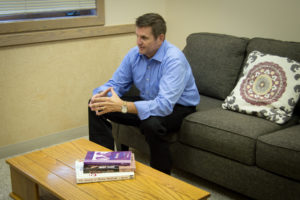
September is National Suicide Awareness Month: Learn the facts, myths and signs of suicide
Front Page, Lifestyle September 14, 2018, Comments Off 220Both at Drury University, in the Springfield community and across the nation, people are taking action against one of the most tragic topics that can be difficult to discuss: suicide.
September is the official Suicide Awareness Month, and National Suicide Prevention Day is September 10. The movement hopes to raise awareness and open dialogue about a topic so frequently under-discussed.
The facts
Suicide is a widespread issue. While there are certain groups that statistically tend to be more at risk, depression and suicidal thoughts can affect anyone, at any time. Suicide and/or depression has likely impacted the life of someone you love.
According to research by the American Foundation for Suicide Prevention, Missouri’s suicide rate per 100,000 individuals is 18 percent, considerably higher than the national average of 13 percent. The foundation also reports that suicide is the 10th leading cause of death worldwide.
Suicidal thoughts common among students
Ed Derr, the director of counseling and disability support services at Drury University, noted that suicide is the second leading cause of death for college students, and the rate of suicide is increasing; it has jumped about 30 percent since 2000.

Photo via Ed Derr.
When asked whether students on campus talk about suicide, Ed Derr replied, “Absolutely. Stress and anxiety and depression often bring students into counseling, where the question will be asked, ‘Have you ever thought about dying?’ It’s through that direct, assertive communication that people will reveal, yes there are some [suicidal] thoughts that will arise.”
A national health concern
“One person dies every 11 minutes in our country,” said Derr. “One young person between 15 and 24 dies every hour and 32 minutes by suicide. In our country, 122 people die every day by suicide.”
Derr said that statistically, women attempt suicide more often than men, but men complete suicide at a higher rate. Derr also stated that for every one death by suicide, there are 25 attempts.
“That translates to an attempt every 28 seconds: three female attempts for every male attempt. This is why this is a national health concern.”
Derr cited the National Institute of Mental Health, noting that certain age groups are at a higher risk. People between the ages of 15 and 24 and over the age of 60 are most likely to struggle with suicidal thoughts.
The institute analyzes data to see if there are other factors, such as race, that may lead to higher suicide rates in certain demographic groups. While there do appear to be groups at higher risk than others, it is important to note that everyone, regardless of background, can experience these thoughts and should always immediately reach out for support.
Kimberly Hale, co-chair of the Suicide Prevention Coalition of Southwest Missouri, offered some insight into what factors might lead to suicidal thoughts.
“This is not a new problem. It’s something we face throughout the area, particularly with youths and teens,” said Hale. “Some big factors in attempts for young people are depression and anxiety, as well as self-harm.”
Hale also identified bullying, drug abuse and major life changes, such as moving to college, as contributors to depression and anxiety which may lead to suicidal thoughts.
“Probably everyone has been, or knows someone who has been, touched by this sort of loss,” Hale added.
Looking out for your friends
When asked how to identify whether a friend or loved one might be having suicidal thoughts, Hale listed six main symptoms to watch out for: withdrawing and self-isolation; aggression; short-temperedness; unusual sleeping patterns (far more or far less than normal); reaching out to distant relatives or friends; and/or giving away valued possessions.
“When reaching out to someone you feel might be harboring these thoughts,” Hale said, “it is important to let them know they can talk to you. Take them seriously; don’t be judgmental or dismissive. It’s O.K. to ask them the question, ‘Are you suicidal?’ Many people think asking that question gives them the idea. That simply isn’t true.”
The organization Hale works for, the Suicide Prevention Coalition of Southwest Missouri, is an organization based in Springfield, Mo., dedicated to reducing suicide rates through education and support for survivors and families of victims. For more information about the Coalition or to find out how you can help, visit www.preventsuicideswmo.org or visit their Facebook page, www.facebook.com/SPCSWMO/.

Photo via Keagan Merritt.
Myths about suicide
Derr dispelled several myths about suicide, such as the myth that asking someone if they are having suicidal thoughts will increase their risk of suicide. According to Derr, the truth is that open communication can lower anxiety and lower the risk of an impulsive act.
Another myth is that only experts can prevent suicide. Anyone can help prevent the tragedy of suicide, Derr explained, even by listening and referring them to additional help.
Perhaps the most meaningful myth Derr dispelled, however, is the myth that once a person decides to attempt suicide there is no stopping them. Derr assured us that suicide is the most preventable kind of death, and almost any positive action may save a life.
The important thing for anyone with suicidal thoughts to remember is that you are not alone. This is not an uncommon issue, and many people face it every day. There is help out there for anyone having suicidal thoughts.
Drury leaders take action
Given the magnitude of the issue, college campuses and community organizations are trying to de-stigmatize mental health issues in order to combat these completely preventable tragedies.
Panthers for Prevention and the Counseling Office is hosting Drury’s own Suicide Prevention Week Sept. 10 through 14. Hosting different events each day, the organizations aim to raise awareness, inform and support those who may be dealing with mental health issues.
The week finishes with a prize giveaway for students who complete the online “Ask. Listen. Refer” training. Panthers for Prevention aims to equip students with the knowledge of what to do if their peers are experiencing suicidal thoughts or feelings.
Recent headlines spark conversation
Recent celebrity suicides have put this issue in mainstream media, and their families’ public statements have demonstrated that the signs of suicide can be difficult to recognize. Fashion designer Kate Spade, DJ Avicii and chef Anthony Bourdain are just three of the lives lost to suicide in 2018 that took the national spotlight.
It is important to recognize that anyone, regardless of wealth, status or other factors, is at risk for suicidal thoughts. Even those who seem completely happy may be struggling and reluctant to ask for help. Events like Drury’s National Suicide Prevention Week shed light on the topic and teach students how to help friends who may be thinking about suicide.
Media outlets have had to examine the way they report celebrity suicides and aid in prevention. Some magazines like People and Entertainment Weekly have put the suicide prevention hotline on their covers. According to its operators, the hotline saw the largest volume of calls following the deaths of Kate Spade and Anthony Bourdain.
Drury has several resources available to those dealing with any mental health issues. Students have access to free counseling through the university by contacting the counseling office at (417) 873-7418. Drury students can reserve an appointment for counseling, or just walk in (no appointment necessary) on Tuesdays at 8:30 a.m. to 11 a.m.
The National Suicide Prevention Hotline is 1-800-273-8255, or 1-800-273-TALK. The hotline is open to all callers, whether you are concerned for someone else, having suicidal thoughts yourself or just having a bad mental health day.
Written by Olivia Thompson and Forest Swisher.